


 |
September 25-29, 2015: Steve Lee Visits Me in Dallas |
 |
August 22 - September 3, 2015: House Sitting in San Antonio |
 |
Return to the Index for 2015 |
Today, Fred and I are heading over the the Dallas Arboretum late this afternoon for an event for members- An Evening at the Fall Festival. From mid-September through Thanksgiving, the Arboretum has its Fall Festival, the centerpiece of which is the huge Pumpkin Village for adults and kids. In addition, the Gardens are decorated throughout with gourds and pumpkins. Today, there will also be evening entertainment throughout the Gardens, with a number of individuals and groups performing. This is what we have come to see. I also called our friend Steve, who enjoys the Arboretum as well, about meeting us there. He could come but Mario couldn't, so I got three tickets for us and Steve met us at the Members Entry.
Getting to the Dallas Arboretum
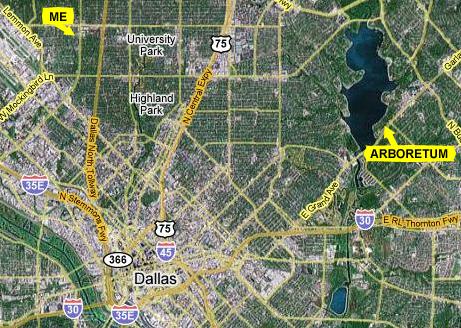 |
 |
The bike path used to cross the top of the dam, but for one reason or another, the bike path was rerouted a year ago, and now it goes through some parkland and playing fields south of the dam, across the spillway, up Garland Road for a ways, and then back north along the lake shore.
You can also see a closer view of the Arboretum in this picture, and can begin to pick out some of the pathways through the gardens.
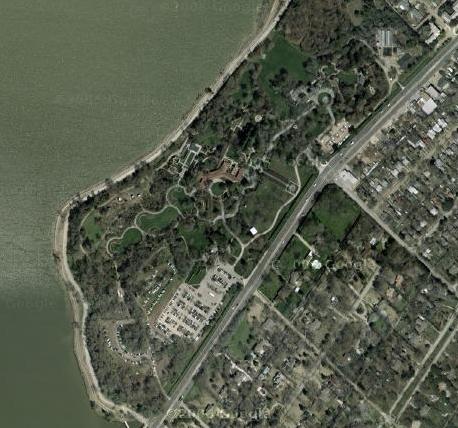 |
You can also see the maze of pathways that criss-cross the gardens.
Fred and I went from the house across town on Mockingbird Lane, then south on Buckner Boulevard to Gaston Avenue. Then we came back southwest to the main Arboretum entrance. We usually make a circular transit of the entire Arboretum each time we visit, but today we will be concentrating on walking the Paseo del Flores- the main walkway through the Gardens.
|
1. Main Entry
2. Jonsson Color Garden/Main lawn
3. Display Gardens
4. Paseo del Flores (white line)
5. Pumpkin Village
6. DeGolyer House
7. Red Maple Rill (top, extends north)
8. Camp House
9. Performance Stage
10. Lay Family Garden
The Paseo is the main walkway through the gardens. It begins at the Arboretum Entry, where during the festival there is a display of fall plants as well as pumpkins and gourds. The Paseo leads past the display gardens, where there is always a lot of color, and then past the Pumpkin Village. It also passes the DeGolyer house, the Garden Restaurant and the Red Maple Rill- a beautiful, shady area of the gardens. It ends at the entrance to the Lay Family Garden, which is right next to the Alex Camp house. Behind the Camp house is the performance lawn that slopes down to White Rock Lake.
With that bit of orientation in mind, we can look at some of the many pictures we took on our visit today.
At the Arboretum Main Entry
|
For the Fall Fesitval, there is always a huge display of pumpkins and gourds in the middle of and all around the entrance plaza, and this evening was no exception.
I think the display of gourds was more amazing this year than last; it is hard to describe the variety of them. They were of all sizes, shapes and colors, and it seemed that no two were at all alike. We took a number of pictures of the displays, and tried to get at least one picture of each of us with one or another of the groupings. Click on the thumbnail images below to see some of the many pictures we took around the entry plaza:

|
As I may have mentioned above, the event this evening in the Arboretum supplemented the usual Fall Festival displays with a number of musical groups and individuals performing around the gardens. We encountered the first of these performers here in the entry plaza- a harpist who was playing Pachelbel's "Canon in D" at the time we were in the plaza. Of course, we took still pictures of her and Fred made a very good but short movie of her performing. At left below is a player you can use to watch her performance, and beside that player to the right are two still pictures we took of her:
|
 |
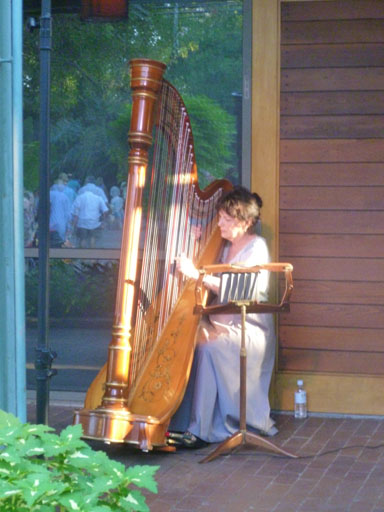 |
Actually, I'd forgotten until I saw and heard the harpist that the online description of tonight's event mentioned that there would be these performances. I think we ended up seeing four or five of them as we wandered around the gardens.
|
|
So I began my movie by focusing on the harpist for a few seconds, but then, with the music as a backdrop, I panned 360° around the entry plaza going counter-clockwise starting and ending with the harpist. You'll be able to see the entire plaza, and towards the end of the movie you'll notice Fred rejoining me after taking his own movie and still picture.
You can use the player at right to watch this movie.
From the entry plaza, we turned right to walk down the beginning of the Paseo del Flores. Along both sides of the flagstone walkway there continued to be row upon row of pumpkins and gourds, and just before we got to the trial gardens I took this picture of Fred and some pumpkins.
In the All-America Selections Trial Garden
|
|
Each garden location "enters" plants into a judging process run by AAS Judges; they score each entry from 0 to 5 points, with 5 being the highest. Judges report their scores after the growing season for that variety. Judges are located in geographically diverse areas all over the U.S. and Canada. AAS uses an independent accounting firm to calculate the average score of each entry. Only the entry with the highest average score is considered for a possible AAS Award. The AAS Judges determine which, if any, new, never-before-sold entries have proven superior qualities to be introduced as AAS Winners.
The Judges look for significantly improved qualities such as earliness to bloom or harvest, disease or pest tolerance, novel colors or flavors, novel flower forms, total yield, length of flowering or harvest and overall performance. In the last ten years an entry needs to have at least two significantly improved qualities to be considered by Judges for an AAS Award.
The AAS Winners offer gardeners reliable new varieties that have proven their superior garden performance in Trial Grounds across North America, thus, our tagline of "Tested Nationally and Proven Locally®". The garden here at the Arboretum is one of these trial grounds. This evening, the trial gardens were especially beautiful, and we took a great many pictures- well, at least I did. I found each flower bed more colorful than the last, and just couldn't stop snapping away. I have put most of these pictures into the slideshow below.
|
|
While in the trial garden, we heard another performer, so we went over to the DeGolyer house to see who it was.
The West Portico of the DeGolyer House
|
Fred went out onto the lawn, as you can see in my picture at left, to focus in on the performers, and he got a good closeup of the performing duo.
After I took my picture looking onto the lawn from the Paseo, I myself went out into the center of the lawn to get my own picture of the performers, the DeGolyer house, a portion of the lawn and some of the folks gathered around to enjoy the performance. I think the picture turned out well, and you can see it here.
Both Fred and I took movies while we were here listening to the performers. My movie, that you can watch with the left-hand player below, begins by moving from the lawn up closer to the performers to listen for a bit and then panning across the lawn itself to see the folks gathered there. Fred's movie, viewable with the right-hand player below, focuses on the performers themselves, and gives you a good opportunity to hear a bit of their music.
|
|
|
From the performance at the DeGolyer house, we headed back across the Paseo towards the Pumpkin Village. As you've already seen, there are pumpkins and gourds all throughout the gardens- not just in the Village. We saw one of these displays. Crossing the Paseo, we also walked by a new fountain and small but elegant fountain called "The Garden of Memories", an area given to the Arboretum in memory of a private individual.
Pumpkin Village
 |
The Arboretum brings in many thousands of pumpkins and gourds each year. Some are used as decorative borders, both in Pumpkin Village and elsewhere in the gardens. Many of the pumpkins are gathered together in Pumpkin Village in huge pumpkin collection, where kids and other folks can wander through. Sometime in October, I think, the Arboretum begins allowing visitors to purchase the pumpkins in the collection, although the border displays and other pumpkin constructions remain. Here are a couple of pictures of us with the pumpkin collection in the background:
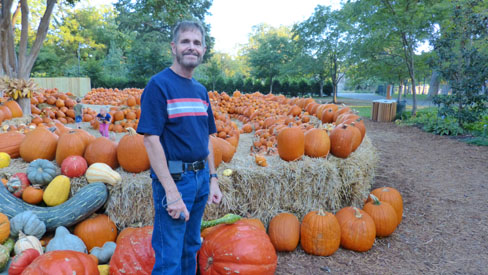 | 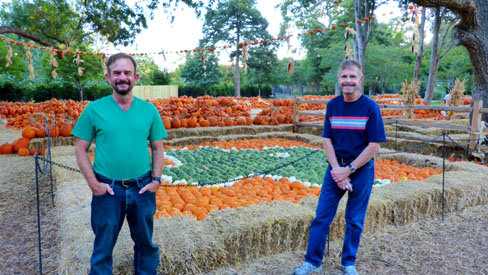 |
The other use to which the pumpkins are put is as a construction material for building a series of western- and frontier-themed structures that kids and their parents can actually go inside. From a distance, it looks as if the structure walls are just stacked pumpkins, but a closer inspection reveals how the structures are built.
|
You can see that the pumpkins and large gourds are actually sitting in metal holders, and are put close enough together to give the impression that the pumpkins are just stacked into walls.
On either side of the post office structure there were what are supposed to look like wanted posters (as you would have seen in a frontier building. They are actually photo ops, as you can stick your face in from the back while someone takes a picture from the front. Mostly for kids, I went ahead and did it anyway, and had Fred take my picture.
Before we look at another structure, you should have a look at the close-up picture of the post office that Fred took. He wanted to capture some of the neat decoration on the outside of it, but again it also shows a bit of the construction method.
|
If you would like to read that informative sign you can see in the picture, just click here.
I also took a couple of pictures here at the General Store, and you can click on the little thumbnail images below to have a look at them:
 |
The third actual building (and the smallest of all of them) was the Sheriff's Office and jail. It also had a sign out front with a short description, and you can read the sign if you click here. I actually walked through the Sheriff's Office to get a picture from the other side.
|
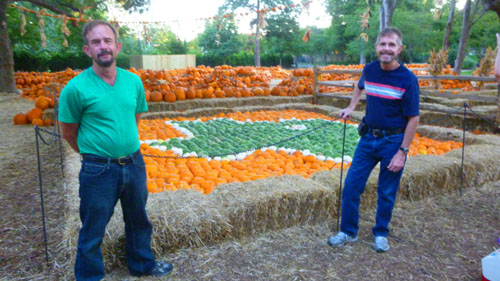 |
Before we look at the last of the displays, Fred took a couple more good pictures of the pumpkin and gourd displays, and you can have a look at them here and here.
|
|
And for a couple other view of the Gold Rush display, just click on the thumbnail images below:
 |
As we walked over to the last display, I did get a picture of that display and the Gold Rush display, and you can see that picture here.
|
There were some other small displays, including a scarecrow, and below are some clickable thumbnails for a few of the other pictures we took of them:
 |
Wandering around the Pumpkin Village was, as it always is, a pleasure, and there are a couple more pictures that are interesting enough to include here.
|
|
Below are clickable thumbnails for our last two pictures of the really great pumpkin and gourd displays:
 |
Along the Paseo
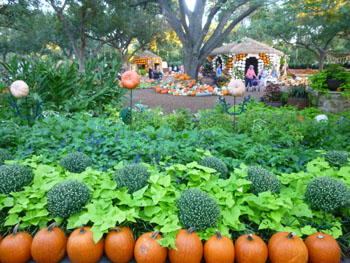 |
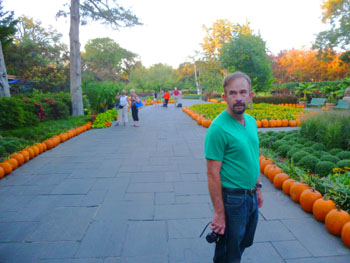 |
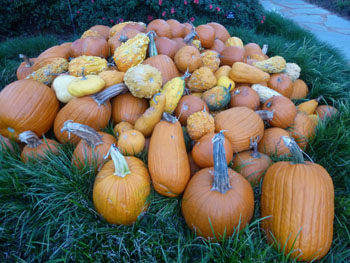 |
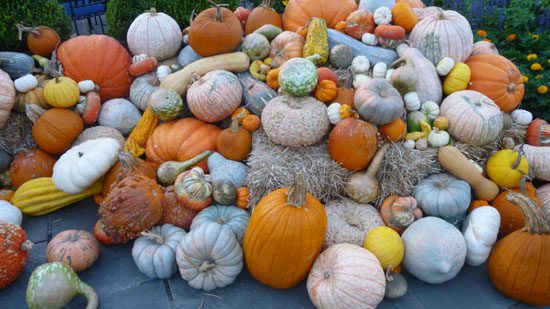 |
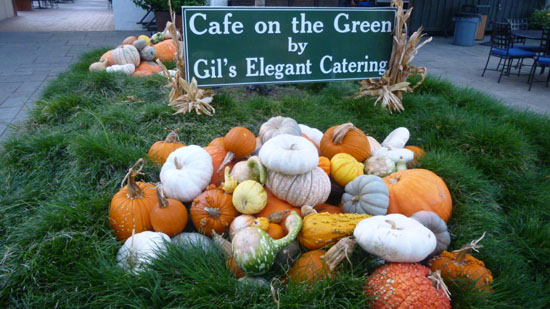 |
At the Top of the Nancy Rudchik Red Maple Rill
 |
Here, as you can see, there were two performers doing instrumental selections, and both Fred and I made movies. His (left-hand player below) focuses on the performers, while mine surveys the entire area using the music as a backdrop. Have a look at both movies:
|
|
|
In the Lay Family Garden
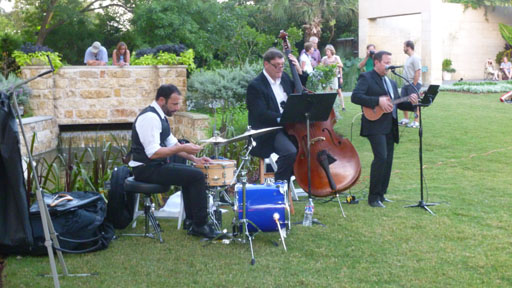 |
|
Our Evening Visit Ends
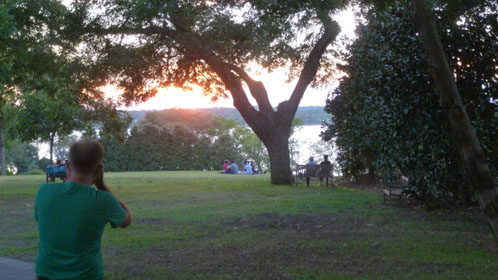 |
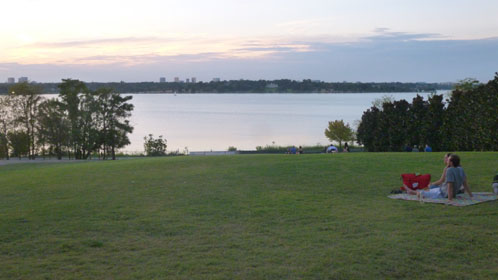 |
The last two pictures are of the infinity pool at the Womans Garden, which overlooks White Rock Lake and of the sunset at the end of our day:
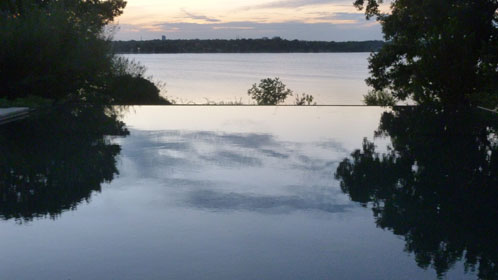 |
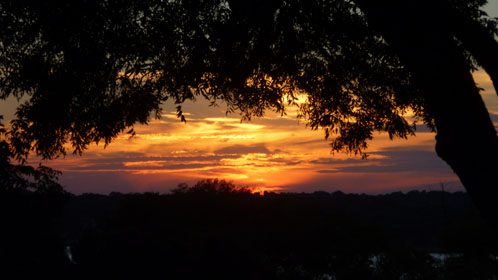 |
This was the first time in years that we have been to an evening event at the Arboretum. It was very enjoyable, and we should go to more of them.
You can use the links below to continue to another photo album page.
 |
September 25-29, 2015: Steve Lee Visits Me in Dallas |
 |
August 22 - September 3, 2015: House Sitting in San Antonio |
 |
Return to the Index for 2015 |